Off Roaders Are Super Comfortable, But Your Parents SUV Probably Isn't.
There appears to be some misunderstanding about how suspension works and why it makes an off road vehicle work as a comfort vehicle on the road. Conversely, there’s some confusion why a lot of SUV’s don’t ride as well on the road as you would expect.
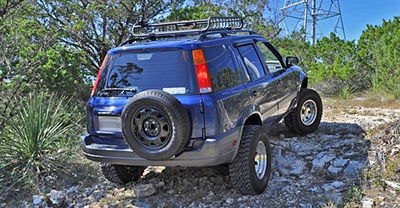
There appears to be some misunderstanding about how suspension works and why it makes an off road vehicle work as a comfort vehicle on the road. Conversely, there’s some confusion why a lot of SUV’s don’t ride as well on the road as you would expect.
Let’s first understand there are two broad types of SUV’s available - SUV’s that are designed and built to be capable off road in almost any terrain, and SUV’s designed to be sold as a normal road vehicle but with the benefits of a higher ride hight, larger load capacity and more room for the driver and passenger than a standard car.
Now, to understand why an off roader tends to be a smooth ride on the road is also to understand why they don’t actually handle well. In essence, it’s the opposite way a race car may handle well on the road but the ride quality is going to rattle your teeth.
An off road vehicle needs to have the suspension travel for the wheels to individually reach down or up in order to maintain it’s mechanical grip on the surface it’s traversing. On a bumpy piece of ground, each wheel may be at a different length away from the chassis of the vehicle and the suspension needs to either compress to allow each wheel to travel over a bump, or droop down and allow it to descend into a hole or a rut.
Droop is defined as the amount of downward suspension movement there is in the wheels of a car.
The base measuring point for this droop can either be the chassis or the ride height of the car. Travel is the amount that a suspension unit can compress.
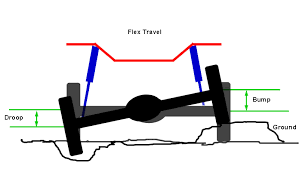
To achieve this, and due most off roaders having solid axles, we need to understand axle articulation.
Axle articulation is how far the axle can move up and down on opposite sides relative to the chassis.
Articulation is what allows the vehicle keep all four tires in contact with the ground on rough terrain, which provides better chassis stability and allows the vehicle to maintain traction.
In even simpler terms, it’s what allows the right hand wheel in the above picture to go up while the left wheel can travel down.
Most off road vehicles have three differentials, one in the front axle, one in the rear axle and one in between the drive supplying power to the back and front axles. If a wheel leaves the ground, unless a diff is locked up, the wheel not in contact with the ground will use all the power it’s given to spin and the opposite wheel will not turn - meaning now the opposite end (front or rear) has to do all the pulling or pushing.
If one of those wheels leaves the ground at the front and one at the back, the car will then be unable to move. Some cars come with the ability to lock the diffs and stop them having an effect and they are a popular aftermarket modification for serious off roading, but either way four wheels on the ground are the ultimate aim.
The picture below demonstrates what extreme axle articulation looks like.
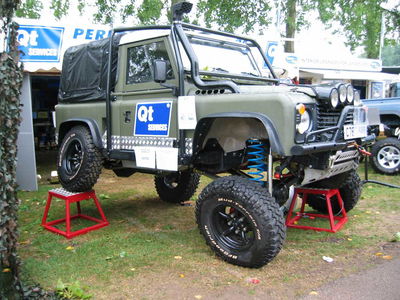
The following picture demonstrates how much articulation there is in a stock Range Rover. It also demonstrates that a key ingredient to axle articulation is the spring rate used - the springs have to be fairly soft to allow the upward travel of the wheel until it reaches the bump stop while keeping the frame level so the opposite wheel can drop as low as it’s droop setting allows.
Too stiff and articulation is lost.
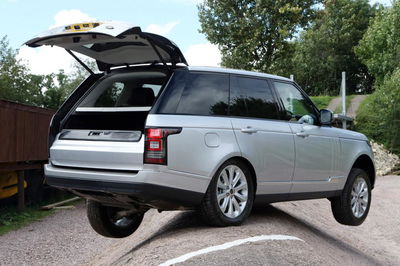
This softer suspension than a road car is largely why ride quality in off road vehicles has traditionally been better than almost anything else on the road, however, it’s also the reason why they don’t tend to handle and grip a normally paved road so well. Soft suspension increases the effects of the high centre of gravity inherent in a tall vehicle. (Roll centre is more accurate but complex term, so for the purposes of this article, centre of gravity is a simplistic term that works but I want to mention that for the comment pedants.)
The bottom line though is you end up with exaggerated diving under braking that reduces the grip of the rear tires, excessive lean in corners reducing the mechanical grip of the outside wheels and if you’re my wife in the passenger seat coming down a twisty mountain road… sea sickness.
Now, I used the word traditionally for a reason as nowadays more things come in to play in modern off roaders, and we’ll stick with the Range Rover as one of the best examples there are of a luxury off roader.
The Range Rover was originally designed to be a comfortable vehicle that a farmer could load with hay or people and travel across his farm in any weather and in a comfort level not afforded by a traditional Land Rover. Traditional Land Rovers were, realistically speaking, trucks designed to do the same thing but with more of a load bearing capacity. Hence they had/have stiffer suspension to compensate for that weight.
I actually owned a 1962 Series II 88” Land Rover complete with leaf spring suspension. That thing would go anywhere the Range Rovers went, but boy did it bounce and feel like it would tip over where a Range Rover was still quite comfortable.
So, what comes into play in very modern off roaders?
Off roaders nowadays are expected to spend more time on the road as a luxury vehicle, so a few things can happen.
Check out the difference here in tire sidewall height:
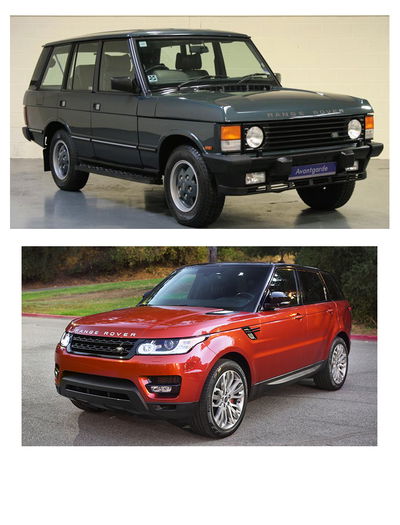
The sidewall is the part of the tire between the inside diameter (where the tire meets the wheel) and the outside diameter (where the tire meets the road). The effect of this thicker sidewall for both grip off road and comfort on road can surprise people. Its cushioning effect over small bumps effects ride comfort quite dramatically, however the more sidewall there is the more it will “give” when the weight of the car is pushing it to the side. The effect on handling is to make the vehicle feel, and actually lean and roll more than a tire with a shorter sidewall in corners.
As you can see in the above photo, the classic Range Rover came with smaller wheels, and tires with a noticeably more substantial sidewall.
A thinner sidewall of course makes steering more direct and improves handling (there is a point of diminishing returns, but that’s a whole other article) but you can feel more of the road surface including bumps and ruts.
The dynamics that have more effect though are the suspension settings available now in these vehicles. Generally there is an off road setting and an on road setting, then sometimes a sport setting.
The road settings are where the automaker tries to make up for the handling issues inherent in these off road capable vehicles by firming up the shock absorbers and in some cases the sway bars…
(short over simplified version: sway bars apply upward pressure on the inside wheel(s) through a corner in order to keep the chassis as flat as possible - for dedicated off roading sway bars are often removed because the movement inhibits axle articulation.)
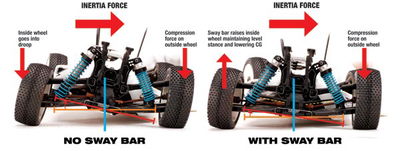
… the problem being that to make a car that size and height handle anything like a road it needs to be stiffened up more than an actual road car - including the sway/anti roll bars.
This has actually become more apparent over the past decade. I drove a 2001 Range Rover for a few years and it had adjustable suspension. It had a high high setting for when you need that ground clearance, normal for road use and highly capable off roading, and low for smooth highway driving. At least that’s what I think low was for because the low setting was horrible everywhere else. I only took it out of the middle setting a few times for high when sharp rocks were around. That thing saw forest trails, rutted tracks down mountains, dunes in the badlands as well as snow and some very deep water. It was one hell of a machine in the normal setting and an absolute dream for around town driving as it felt like it had pillows for suspension.
Actually, it did have pillows. It was the first generation of air suspension on Range Rovers - hence the adjustability.
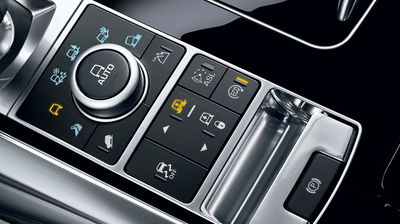
Anyway, at the beginning of this rather long piece I said here are two broad types of SUV’s available. We’ve covered vehicles built to off road, so let’s talk about the others.
They are the vehicles sold as a normal road vehicle but with the benefits of a larger load capacity and room for the driver and passenger than a standard car. Arguably, because it can be down to perception, higher ride height for improved visibility in traffic is the benefit most often cited and argued about.
The problem is they have all the same handling issues as an off road vehicle but they aren’t designed to go off road - often front wheel drive with only one diff, fully independent suspension and no low ratio second gear box .
They are tall with a high roll centre. So to sell them to people that want, and for safety need, their vehicle to handle like a car but with all the room and height of a traditional SUV then the suspension has to be set harder than a normal passenger car to get it into the same ballpark.
Hard suspension of course will let you feel every bump or every piece of rough road the wheels roll over - and even more so with the road car sized tire sidewalls, and that’s why your parents SUV isn’t as comfortable to ride in as people tend to expect.

I will leave this piece there, and thank you for reading all the way through this lengthy word jungle. It’s been a bit dry so I’ll leave you with a picture of my dads current off road machine - a mad scientist cut and chopped Land Rover Discovery. I sold him my Land Rover a long while back and he loved it but found the leaf springs not doing his back much good. Since then he’s been through a steady progression of off roaders from Land Rovers to his current Toyota Land Cruiser. Last time I spoke to him that was unmolested, but he has a workshop and he’s retired so that’s probably changed by now.

If you have never been off roading, trust me here and try it. It’s basically the most fun and biggest adrenaline rush you can have at 5 to 10 mph.
#blogpost













Comments
Great work, but explain to me why my XJ Cherokee rides like a Conestoga wagon?
Have to replaced the wooden wheels?
Struts. It’s always struts.
Great article
Great article! I saw that off road post earlier and once I was done reading it I was like “I’m kinda skeptical about whether you’ve actually gone off roading or not.”
To be fair I haven’t been off roading either but even I know some very very (very) basic things about off roading regarding the suspension.
Nice!! Matt Robinson Alex Kersten
Great article, I also had raised my eyebrows when I was reading the other article on the subject. Funnily enough my stock Xterra Pro-4X is quite comfortable on the road despite leaf springs in the back but also doesn’t lean as much as one would expect.
I don’t know what you;’re talking about. They corner just fine to me.
Hey the racing game that got me into cars was about off roading! :D
(Ya Boy) Ethan Clark (Corvette Enthusiast) (Maxima Squad) tagging you here so harassment guy doesn’t see it.
I appreciate you calling in the mods to clean him up. I just ignore him, as contact of any kind just makes him feel like he’s having an effect. If you just don’t acknowledge him and call a mod, that’s perfect.
Pagination